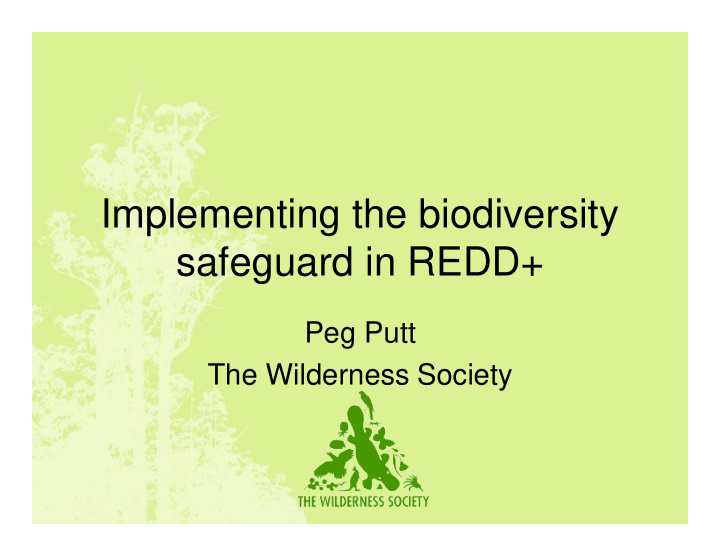



Implementing the biodiversity safeguard in REDD+ safeguard in REDD+ Peg Putt The Wilderness Society
Text of ‘biodiversity’ safeguard The following safeguards should be promoted and supported: (e) That actions are consistent with the conservation of natural forests and biological conservation of natural forests and biological diversity, ensuring that the actions referred to in paragraph 70 of this decision are not used for the conversion of natural forests, but are instead used to incentivize the protection and conservation of natural forests and their ecosystem services, and to enhance other social and environmental benefits
Elements of biodiversity safeguard • Protection and conservation of natural forests • Conservation of biodiversity • No support for ‘Conversion’ of natural • No support for ‘Conversion’ of natural forests • Protection and conservation of ecosystem services • Enhance other social and environmental benefits
• Recognises concurrent values: carbon stocks, biodiversity, ecosystem services generally, other social & environmental benefits environmental benefits • That action in support of emissions reduction and carbon sequestration may not be sensitive to the non-carbon values
Natural forests & conversion • Assumption that this safeguard prohibits funding the conversion of natural forests to plantations under REDD+ • To operationalise this we need to fix the • To operationalise this we need to fix the definition of forest so as to differentiate between complex, biodiverse natural forests and planted crops of perennial woody plants (plantations) • This must be addressed by SBSTA
The problem • Current definition in use at UNFCCC (adopted from FAO for LULUCF in the Marrakesh Accords) • Conversion of natural forest to plantation • Conversion of natural forest to plantation is not defined as deforestation, as both fall under the definition of forest • It obscures forest degradation – caused by industrial scale logging, for example This is also an issue for implementing the carbon mission of REDD+
The solution? • Adopt the principle categories of forest that sit under the FAO definition: • Primary forest • Other naturally regenerated forest • Other naturally regenerated forest • Planted forest • Deforested & drained peatland forests should also be categorised as forests. They naturally regenerate to forest in the absence of drainage
Biodiversity • Biodiversity plays a role for effective & long-term carbon storage in forests – confers resilience, especially in intact natural forests natural forests • Therefore considering biodiversity in implementation is fundamentally important - a core benefit, not simply a co-benefit • Synergies: simultaneously address climate change & biodiversity crisis
Biodiversity (cont’d) • Forest restoration (enhancement of forest carbon stocks) has biodiversity & carbon benefits – natural regeneration more benefits – natural regeneration more effective than tree planting • Involving indigenous peoples & local communities is essential – they are stewards of forest resources See CBD Technical Series No. 59 – REDD-plus and Biodiversity
Cautionary note • Interpretation of what constitutes biodiversity conservation has been applied to ‘SFM’ industrial scale logging, as follows: • A few representative examples of endangered ecosystems or forest communities are retained ecosystems or forest communities are retained • Comprehensive protection of biodiversity is not required • Leading to ‘slivers’ & ‘scraps’ - islands in a sea of logging. • Such fragments are prone to ongoing degradation and loss.
Other ecosystem services: Soil & water conservation Forests are • A buffer against soil erosion Forests regulate • Water quality • Water quantity – maintain summer flows / avoid floods
How to apply the elements of this safeguard concurrently and most effectively? • Common element is that all these values require avoidance, or reduction, of anthropogenic disturbance, and anthropogenic disturbance, and • Restoration of natural integrity where already degraded This is also required to achieve optimal carbon conservation & enhancement
Hierarchy to Prioritise Actions (according to national circumstances – ie position on forest transition curve) This hierarchy concurrently addresses carbon conservation and enhancement goals – the core mission of REDD+
1. Protect and maintain intact natural forests - keeps big carbon stores intact for big early gains, protects biodiversity, enhances stability & resilience, maintains soil and water 2. Restore degraded natural forests – rebuilds carbon stocks, biodiversity, soil and water carbon stocks, biodiversity, soil and water quality and water regulation 3. Apply sustainable management of forests where areas are already in production and will remain so (but do not introduce to new areas under REDD+ funding) – to improve carbon, biodiversity, soil & water attributes
Recommend
More recommend